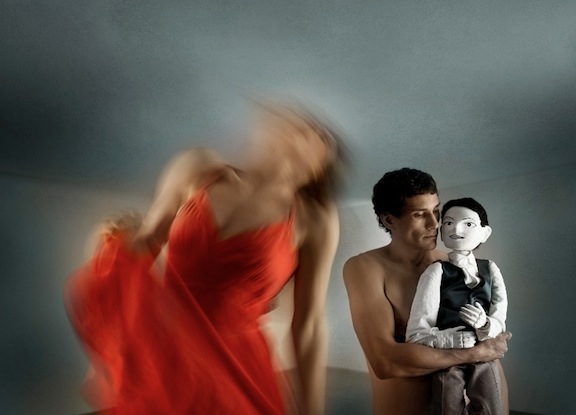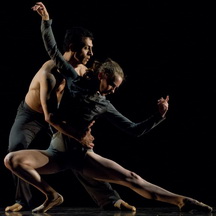San Francisco’s Joe Goode

Joe Goode Performance Group is currently presenting a two-part program at Z Space in San Francisco. The program consists of earlier pieces linked by their common theme of male sexual identity, revealing in the course of their movements how those identities are socially provoked, determined and criticized. As always Goode is impressive, not only for his choreographic brilliance but also in his skills as a writer and performance practitioner. Dance tends to be mute, but Goode often uses language in his pieces and his language is always skillfully poetic.
The Saturday performance opened with Goode walking onto the empty stage and seating himself to talk casually and intimately to the audience. He claims that he is doing this to build rapport with the audience and because people have responded favorably to his on-stage conversations. What he also wants to tell us is that he is a performer, even though he is not dancing that evening. He shows the audience headshots from his career as a dancer and actor.
There was a certain poignancy to what he was doing, a poignancy perhaps best explained by the program, which reveals that he has given over a piece he has performed since 1987 to a member of his company. The piece, 29 Effeminate Gestures, had been selected to be restaged as an American master work by the National Endowment for the Arts. Although this pleased Goode, it also caused some doubt, and he commented, “To revisit such a work, and to translate it to another body, another soul, was a huge challenge. I was curious to see if I could relinquish ownership.”
The other soul is Melecio Estrella, a current member of Goode’s company. And what a gorgeous dancer he is! – a fitting interpreter for Goode’s signature piece.
Effeminate Gestures and Wonderboy
The piece begins when the lights come up with Estrella in coveralls standing at the lower edge of the audience. He enunciates with staccato and rhythmic timing the phrase “He’s a good boy, a goo-ood boy,” eventually returning to the stage, where among other things he chainsaws a chair into pieces. But more revealing than the idea of power tools and destruction being linked to masculinity – later in the piece, he uses a drill rather like a gun – is the vocabulary of effeminate gestures.
Fluttery and campy, the gestures are woven into a combination of finger-waving, hip-jutting, suggestive moves that are now and again recognizable as a vocabulary of gay male seduction and affectation. They are seamlessly and gracefully blended into each other, and there is something comic about their self-consciousness. The audience laughed.
Goode changes this vocabulary startlingly by repeating this combination of moves several times, each time shedding some of the “effeminate” quality of the gestures, until the last permutation is wholly and troublingly “masculine.” The piece acknowledges the subtlety and power inherent in movement. It holds our gender prejudices up to the mirror of the dancer’s body.
Wonderboy the second half of the program, premiered in 2008, and is a collaboration between Goode and puppeteer Basil Twist. This is very much a showcase for Goode’s multiple strengths. With a portable puppet theater in the form of a sheer-curtained window looking out on the world, the piece is a narrative telling of an awakening. The little boy puppet in the window feels the miracle of life around him, both in what he sees and what he feels.
Not only is the text wonderfully written, but also it is wonderfully performed by the group, who constantly change places as both speakers and manipulators of the mannequin. The staging is quite simply brilliant. And Wonderboy is entirely successful at portraying the feeling of wonder that the truly innocent feel when faced with joy of creation and the complexity of human emotion.
– Jaime Robles
Photo: Basil Twist and Wonderboy. Copyright Joe Goode Performance Group.
